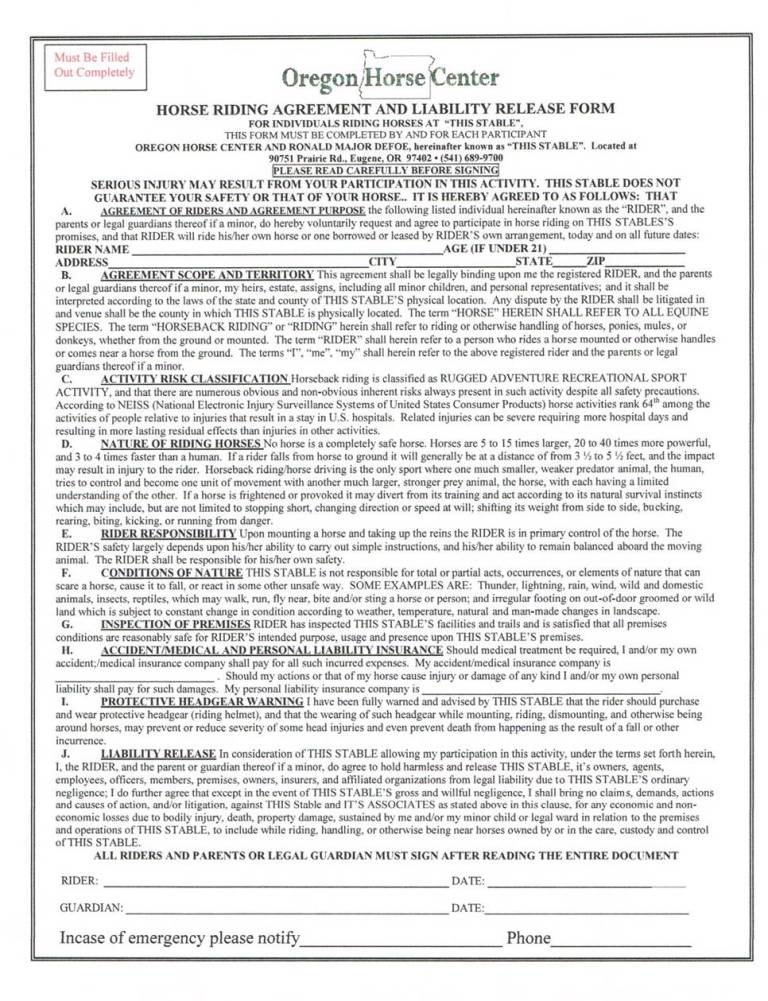
RIDE COMPETITIVE TRAIL TO WIN By Vickie Zapel, PrI Copyright©2013 |
Lesson Two HOW TO ENTER AND PROCESS THE FORMS During 2013 American Quarter Horse Association (AQHA) annual membership meeting, the Board of Directors agreed to sanction “Competitive Trail Challenges” on approved courses. This action gave competitive trail another popularity boost, as AQHA is the largest breed association in the world with more than 50,000 members. This means if you are riding a registered Quarter Horse you can earn AQHA points. If you participate in one of the AQHA sanctioned challenges, but are not riding an AQHA registered horse, you can still win competition points toward the sponsored Challenge’s class awards and highpoints. Your AQHA membership must be current to accumulate AQHA points. The AQHA judging rules will be covered in greater detail in lesson three. Even at the AQHA sanctioned events, you will still see every make and model of horse with every level of rider in a multitude of different class categories, so the AQHA sanction does not limit you in anyway. If you don’t ride a Quarter Horse you can still win competition points and if you do ride a Quarter Horse, you can earn the Competitions own points and accumulate permanent AQHA points for your Quarter Horse, adding to the value of horse. THE NEW INTERNATIONAL MOUNTAIN TRAIL CHALLENGE ASSOCIATION International Mountain Trail Challenge Association or IMTCA formation was legally formed in May of 2013. For details on the association and scheduled events, visit the website: www.IMTCA.ORG. The International Mountain Trail Challenge Association was founded by Mark Bolender, owner of Bolender Horse Park www.BolenderHorsePark.com. If you pay minimal membership dues, you can now ride in any country in the world and begin to accumulate “IMTCA” points. IMTCA was set up as a profit corporation to encourage good horsemanship and promote the new discipline of Mountain Trail. The association will track the progress of each horse, endeavoring to set the judging standards across the globe, for show obstacles and courses, give each horse a competitive license and issue the IMTCA license and membership registration for the horses. You can ride any breed or a horse without breed registration and be eligible to receive points for your horse at IMTCA sanctioned events. When you join, IMTCA will assign your horse an entry show number for life; it is not a horse/rider combination. The entry number will be on the horse’s IMTCA registration’s license form, along with a photo that you will submit when joining. IMTCA is working with mountain/obstacle show facilities and their management to register horses so points can be accumulated. As of July 2013 this program is in its initial stages. DO YOU LOVE TO TRAIL RIDE AND HAVE A COMPETITIVE STREAK? If you are looking to raise money for a good cause, for your club or organization, or for yourself, and you want to play a bigger role in supporting equine charities and horse rescues in America, then you should check out ACTHA, American Competitive Trail Horse Association. You can even join to become a member for free. ACTHA offers awesome awards from hats, jackets and buckles to saddles and a 4-Star horse trailer along with hundreds of competitive trail rides, year round. Log in at www.actha.us and you can search for competitions near you by zip code. Have questions? Phone them at 877-992-2842 X 720. While logged in at their website, click the information tab and you can handily study their rule book. An ACTHA competitive trail ride can be held on private ranches or public parks across the country. Obstacles are mostly natural and each obstacle has its own judge. You will encounter both natural and manmade obstacles, usually 6-8 obstacles over 6-8 miles of trail, where an individual judge is assigned to each obstacle. Rides are usually held on a weekend and start with a “briefing” before trail riders mount up. The actual ride generally last 2 to 2 ½ hours with five different divisions being offered: open, pleasure, scout, junior and buddy; the day ending with an awards ceremony! To see some potential obstacles found on your ACTHA competitive trail ride click here. Check the website for additional and new obstacles. You can even make a suggestion for obstacles you would like to encounter. Remember that competitive trail is primarily a very new sport. There will be rules and regulations with different governing associations, and there will also be independent organizations that elect not to conform or join a regulating association. That being the case, always check with your breed association to determine if you can earn points or credits. As an example, the American Paint Horse Association is introducing rule SC-312, set to become effective in 2015. http://www.apha.com/docs/default-source/workshop/2013-rule-change-proposals-for-convention.pdf See page 22. This new rule will govern ACTHA riders on Paint horse’s accumulating points to become sanctioned in 2015. For more information you can contact APHA at 817-222-6444. DEFINING THE ENTRY FORM, OR YOUR “SHOW PREMIUM”. Show committees used to mail out entry forms and some still do, but don’t expect that service to continue. Plan on visiting the “show website” and printing whatever information you seek. All entry forms will not necessarily appear identical, but will generally include the same information. You may want to enter early to insure your stall or RV reservation and pay discounted “pre-entry” fees. Many events will let you mail, fax or email your entry form and secure your spot with payment of your stall, bedding and any additional grounds fees. When you get to the event and enter your classes, you’ll most often leave an “open check” so that you can add or subtract classes as the event proceeds. You’ll close out your check at the end of the competition. Even though you have sent in a “pre-entry form” listing classes, you’ll still have to check in at the registration office when you arrive at the event. There you will confirm your classes and present your health and Coggins certificates (if required) and the horse’s registration papers or license (if required). Currently at AQHA sanctioned events you don’t need copies of your registration papers; just your correct registration number. For some events you’ll have to show your membership card in order to earn “association” points. If you travel across state lines with your horse, or go to an association approved horse show before, a negative “Coggins” certificate is a requirement. Check with your veterinarian to be sure you have plenty of time to get a Coggins report prior to a show. At the time of entry, you’ll be given a “show number”, on a thick paper square, approximately 4X6” in size, keep it as neat as possible. Some associations request you keep your number for as long as you show your horse; others may request you keep your number for the year’s series, and other show managements will issue a new number at each show. Be certain to ask about keeping your number. In picture below, note the entry number pinned on bottom right corner of saddle pad, left side of horse |
Assignment: Find and contact a qualified or certified instructor, tell the instructor this is a college course assignment and ask if you can "observe" her or him giving a riding lesson. If that is possible, observe the lesson and write an essay commenting on how you see the quality of the teaching and the value of the information provided. If the instructor will not agree to you observing a lesson, ask if she or he would be willing to make a suggestion on how he or she would go about "schooling" a horse for a specific problem. (You must be prepared to offer a suggested problem.) Write a short report on the trainer's credentials, and his or her approach to solving the training problem you suggested. Please make a note of the course/lesson in the subject line and email your written assignment to me at: vzapel@hotmail.com . I'll do my best to respond within two business days. Remember to include your full name and email address on the document. |
When you write your final
check or pick up your entry number it is always wise to check the “classes” you
intended to enter. The office maintains a list of all class and who entered
them. The horse and rider combination on each entry is identified by
their show or entry number. By double checking this information, you can
catch any mistakes and be certain that the show committee has you entered in the
correct classes. Click here to see a sample of an event schedule and instructions. Reading through all of the information seems like a lot of homework, but if you are unfamiliar with competing and/or the facility, you will definitely want to be informed. It is much easier to know this information before heading to the event so you don't show up with your dog, when dogs are not allowed. You may also discover you cannot keep your horse tied to your trailer all night and that the stall you are required to rent does not have bedding because you were supposed to bring your own. Knowing the details is important; saves time, money and eliminates problems. It is most helpful to know if a concession stand will be available and from what hours and when the management office is open to finalize your entry and pick up your entry number. You'll also want to know what time the show starts and when the Judge's Walk Through will begin. (More information on the "Walk Through", in Lesson Three). |
Most events will require a liability form; please read it carefully. You’ll note in the upper left hand corner in red print, “MUST BE FILLED OUT COMPLETELY”. This is for your own protection as well as the facility/owner/management. The owner/management wants to be certain that you understand that you are riding at your own risk. You will not be allowed to compete without all of the required signatures and you most definitely want your emergency contact information readily available to the show office. In the “online” entry packet there will also be additional information generally referred to as the “show program” or “show premium”, such as the show schedule time line, names of judges, the photographer and information about how to sign up for photos and the list of classes. Class lists can be confusing when you are unfamiliar, so can the rules and requirements for different awards. At the onset of confusion, the best thing you can do is telephone…. ask your questions, making notes for reference. Don’t feel silly, even if you have to ask again when you arrive on the grounds; the more you understand, the more confident you will be. UNDERSTAND THE RESERVATION INFORMATION If your work schedule will allow it, arrive at the competition a day early to let your horse settle in and settle down. Make certain that when you do pull out of your drive, you know the best possible route and you’ve got a map with directions, plus a destination telephone number, just in case. If you are traveling alone (or even with a friend) always call your significant other and tell him or her where you’ve stopped and at what time. Before you get back into your vehicle, walk around your rig, check tires, latches and your hitch. For more information on how to prepare to haul to a competition take the www.horsecoursesonline.com course “Preparation for Competition”. Upon arrival, your horse is in tow; he needs his stall, feed and water. You need to park, off-load and unhitch. When you finally locate the show office there is a long line of other nervous people in a rush. The helpful person behind the desk is swamped and her computer is acting up. It is now that you’ll discover you forgot your reading glasses and cannot read all the paperwork you brought with you. You’ll also realize, now that you need it, you left your wallet on the other side of the facility on the front seat of your truck. Page seven of this link is an example of a registration form. Click here. Moral of the story: ask all of your questions early. You don’t want to be part of the “madness” on show day. If possible, call a week ahead of your departure date to get all your questions answered; you’ll be glad you did. Below please view a short video sample of an obstacle you could expect to find at a competition. This water box is dry with two logs placed in front of it. The gravel footing sinks to a hard bottom and the step up on the opposite end adds to the degree of difficulty. At events that last longer than one day, the management will frequently leave water obstacles, like this one empty, until the second day. On the second day, management would likely fill the box with water and on the third day, there could possibly be a small sprinkler running next to the box that would hit your horse’s legs. Much more on riding obstacles in future lessons of Course Two, “MY HORSE WILL CROSS ANYTHING”. This video taken at Eros Bordeaux Stables near Olympia, Washington. |
WHICH CLASSES TO ENTER? Now that you’ve addressed many minor details, we can a take a step back and consider which classes you should enter? The normal procedure is to enter a few classes that match your skill level and experience. When submitting the entry form at the show office, you’ll generally want to leave an “open check”. Leaving an open check enables you to “add classes” or eliminate some. The general rule is “enter or scratch” at least 3 classes ahead the class to be added or scratched as the office will need time to get the updated entry information to the Gate Keeper. If you are feeling confident you might want to organize your class entries to make you eligible for “high point” awards in a given division. Ask office management the rules concerning “high point” award requirements. Keep in mind that you are away from your horse’s familiar surroundings and he may ride like a true champ at home, but not so much at the competition, at least in the beginning. You may want to begin with the lower level classes for which you qualify, and work your way up the “skill ladder” as you attend additional competitions. You drove a long way and you worked really hard to prepare for this day…so you’re excited and the adrenaline is flowing. How about your horse, he had a long trailer ride and he’s pretty excited too. The best idea is to try to “cluster” the classes in which you want to compete. This allows you to block out time for leading your horse around so he’ll get familiar with the grounds, lunge line warm up and riding warm up, a bath and beauty prep for the class. Now your horse has had a chance to mentally and physically prepare for the competition and so have you. Compete well for the level of training your currently riding, and then rest your partner. Arrival time at the event should be planned to allow plenty of time for all the things you need to do...stall set up, show office sign up, horse warm up, etc. Don’t cut it too close. At your first or second or even third event you are going to learn a lot about your horse. Give yourself plenty of time to learn how he behaves and where you will fine “holes” in your training program. Be sure your horse has plenty of water, has time to relax in his stall, and has time to urinate, eat and rest. After a “riding warm-up” pull his saddle and let him relax in his stall. Be prepared early so you are both relaxed and ready to go when “show time” arrives. THE CHECK IN GATE AND “ORDER OF GO” Generally, show management will post an “order of go” the night before the competition. It is really just a list of the competitors and their entry numbers for each separate class. Each and every “class” will also have a numerical order assigned to the classes on your entry form. The “order of go” is randomly orchestrated on a separate sheet for each class. So, you might be in Class 2, Novice Horse, and your individual entry number might be “101”. Check the Order of Go sheet and you may find yourself as the seventh entry. If you are also entered in Class 5, you may find your entry number toward the bottom of the list or near the top again. It’s a good idea to know your order of go well ahead of time. The announcer will be calling class numbers as the day progresses. Before your class is called, you can begin your mental time clock calculating when you should be tacked up, warmed up and physically checked in with the Gate Keeper. Be sure you are ready a few horses prior to your “go”. Remember, this is not a competition where all of the entries to the same class enter the arena at the same time. It is your responsibility to be ready when your number is called. Entries are judged individually. You should be “at the ready” at the starting cone or starting point. The judge will give you a sign telling you to begin your ride. Be ready; never keep the judge waiting. At some events, if you miss your “order of go” the Gate Keeper will let you wait until the last entry has competed and then let you work the pattern. At other shows if you are not ready when called you will simply be “scratched” from that particular class On the other hand the entire event may not specify an order of go, commonly known as “work at will.” Always appreciate the Gate Keeper; they are frequently volunteers and have a long thankless job of standing in one spot, clip board in hand, breathing dust and attempting to keep every competitor in order and moving ahead with no delays. TRACK AND COORDINATE YOUR DIFFERENT PATTERNS Short video clip taken on a different day at Eros Bordeaux Stables displaying a sample of a simple obstacle frequently found in competitive trail. If you study the PATTERN 4 sample included in this lesson you will find three different balance beams or planks in just one facility course. Look for numerical numbers; |
1. Balance Beam. 2. Balance Beam (angled). 3. BIG Balance Beam. |
To study the number “2 Balance Beam”,
shown on the trail pattern # 4, preview the small photo below of the sorrel
paint. Look just past his front left leg and you’ll see the angle coming
up before his next stride. Next photo down, study the perfect entrance onto a beam/plank, notice that both the horse and the rider are concentrating at what path is directly out in front of them. Note the straightness of the horse’s body from poll to hind quarters, it is perfect. More video and training material on how to ride this in future lessons. See video below of long, high narrow plank, which is number 3 “BIG balance Beam, shown on pattern 4. |

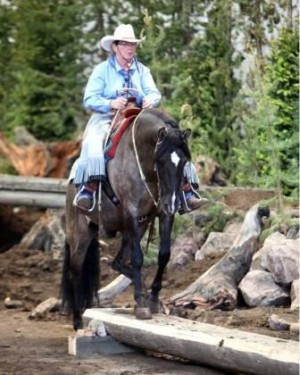
Photo courtesy of Oregon Horse Center in Eugene, Oregon. |
At first glance, this pattern may seem more
complicated than it really is. You will see that this pattern is marked as;
PATTERN #4, which we happen to know is the IN-HAND pattern according to our
entry form which would have been retrieved from the show facility website.
(IN-HAND is where you lead your horse through the course, instead
of riding him, see cute photo of little girl in pink on her adorable pony, while
being hand lead by mom). Photo Courtesy Oregon Horse Center This competitor has hand written on the upper right corner IN-HAND as her own personal reminder of which pattern number 4 is. See the sample registration form that went with Pattern #4. (Below) |
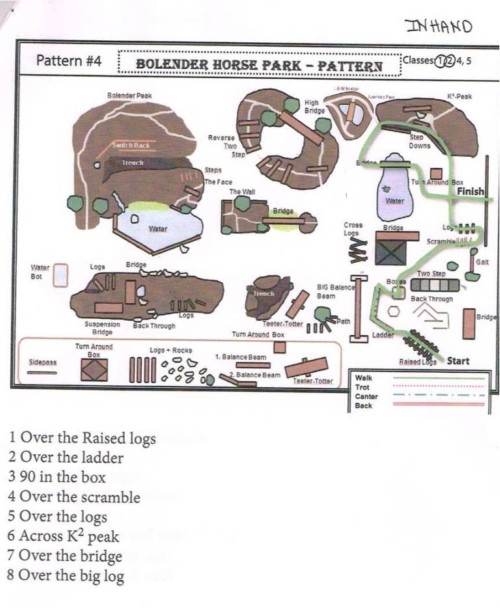
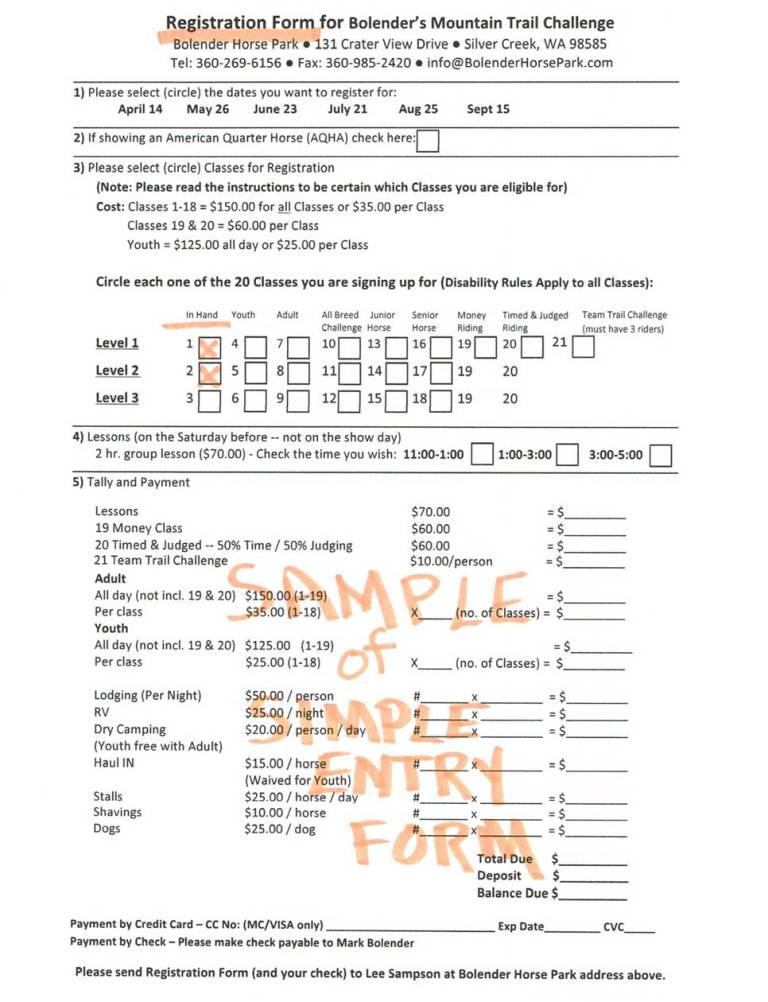
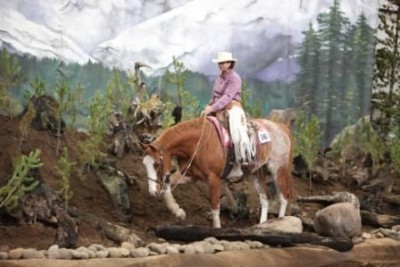

Also note that on her pattern #4 she has
circled class number 1 and 2 on her actual pattern print out because those are
the IN-HAND classes that she personally entered. You can do this with
each pattern class you choose, because many classes will ride the same pattern.
Put one copy of each pattern in your pocket and another copy in your grooming
tote or tack room or the back of your horse trailer. Some competitions
will provide a stack of the different pattern classes early that morning or
the night before, some will simply post one copy at the competition and expect
you to have printed your patterns from their website before you left home. One copy you will need to have with you when you attend the “The Judges Walk Through”. The walk through will be explained in depth in Lesson Three. The second copy is your back up, in case you misplace the first copy or it is in your coat pocket, which you took off because you were hot and hung over a fence rail somewhere and now you are in a rush because the event is moving faster than you anticipated and you really need to study your pattern again. Another helpful idea on show day is to have posted your own copy of your entry form on your tack room wall. At a handy glance you can check the order of the classes YOU entered, to help keep you on track. Most likely, you will have more than one pattern to memorize. KEEPING SAFE IN THE COMMOTION There is maximum turmoil at any horse competition; a combination of humans and animals, generally focused on themselves and not paying enough attention to their surroundings. It is your responsibility to keep yourself and your horse safe at all times. Maneuvering through a crowd of horses and handlers can easily be equated to defensive driving. Look ahead; anticipate the actions of those in front of you. Turn on your mental blinker and make eye contact with the other horse handler/rider who is heading in your direction when you intend to turn in front of them. Watch the mental rearview mirror for potential hazards coming your way. BE ALERT! If you stop moving, think about where you are. Are you in the way? Did you stop in the middle of the main flow of traffic? Can you easily see what is going on around you? Do you have a safe escape route? Do not depend on your horse to be smart about what he is doing. Treat him as if he is a child and you are the parent; pay attention! Don’t let your horse visit, touch or back into another horse. If you have to walk behind a horse that is tied in an aisle way, ask the horse owner’s permission. Give the owner an opportunity to move his horse over. A million times horse owners have said to the passing party, “Oh, my horse is fine”. Well, that is just great until his horse isn’t fine and you’ve put yourself and your horse in a dangerous position with no avenue of escape. Always think about the tight areas and be as safe as possible. If the horse you need to pass gives the slightest indication of being in a foul mood, re-route to reach your destination. You’ve prepared as well as you can at this time for your level of riding and your horse’s level of training. It is best to simply ride against yourself in your own mind. You know when your horse is giving you the best he’s got, and you know when you are riding to the best of your ability. One of the wonderful reasons to compete is to compare yourself to your last ride. Make a mental note of where you find holes in your training. Competing will make your inefficiencies known to you and you can go home armed with the knowledge of where you need to improve. PIN YOUR NUMBER When you pin on your entry number, do it with pride. You may not win the championship, but you accomplished a goal and are preparing for the next. When you attach your entry number, you will typically fasten it to the left side of your saddle blanket or pad. Or you may prefer to adhere it to the center of your back. |
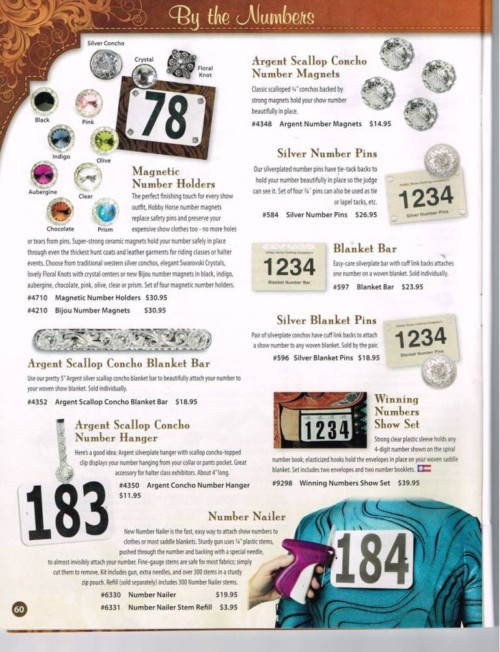
You just reviewed a sample page
of available ways to fasten entry numbers from the 2013 Collection of the Hobby
Horse Clothing Company Catalog. You can visit them on line at www.hobbyhorseinc.com . Remember to double check the back of the number after you fastened it. You do not want sharp pins popping open and sticking you or your horse. To keep your number fresh, clean, neat and easy to re-apply you might consider the half size plastic page cover sheets found at any office supply store. They will help preserve your number card for re-use. If an association assigns your number ahead of time for the duration of your membership, you can have your number laminated to extend its life expectancy. Regardless of where you attach your number or how you attach it, make certain it is easily visible, readable and straight. As you begin your pattern, the judge or the scribe may ask for your number, so remember it! |